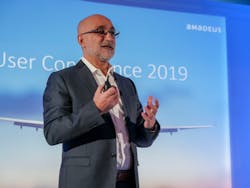Airports and airlines are facing a new host of challenges as the travel industry continues to reopen with the rest of the world. The shift to a touchless end-to-end passengers experience is turbocharged thanks to the pandemic and now the industry needs understand how it will adjust to this new demand.
Airport Business recently spoke with Betros Wakim, Senior Vice President, Americas, Airport IT at Amadeus about this dilemma and how solutions like the Amadeus Flow system can address them.
Airport Business: With the pandemic, how do you see technology playing a more important role going forward to get travelers through airports?
Betros: Everyone is looking at how can we reopen. We’re seeing a lot of initiative on things like touchless. It’s really exciting to see this initiative. While it’s mostly focused on COVID, it’s something we think is going to stay here for good.
When you start talking about reopening, it’s all about how you scale. That’s where the cloud becomes a very important aspect. We’re seeing a lot of our customers ask why do I need to upgrade my infrastructure right now if we can just go to the cloud and I can start scaled down and then scale up as my traffic and processes and passengers starts coming back into my airport?
We’re seeing this shift from getting ready for reopening to looking at where do we go post-COVID. This is where the cloud, biometrics, self-service and more automation are becoming important not just for the recovery, but beyond that. It’s going to be really focused on the customer experience.
AB: Tell me about how Flow works and why airports should be interested in this technology.
BW: It’ a technology, but it’s more about business and operational innovation. For the longest time, as an airport, you think about your processes and how I can service my customers better whether it’s the airlines, the passengers or the concessionaires. When I walk into an airport, I have a lot of decisions. If I have a bag, I can walk up to a self-service bag drop and there are several ways I can interact with it. You can use biometrics. You can also control it remotely and totally touchless. Same thing for kiosks. Then you go to security where the TSA picks up your boarding pass and ID, but they don’t need that anymore. Biometrics can tell who you are and you just walk through security. You walk to your gate and at every touchpoint you can have biometrics all the way to boarding the plan.
All that put together is what we consider Flow. Whether you want to do it all by yourself with biometrics or if you want to still interact with an agent you can still do that. Flow is automating the processes from end to end.
AB: Is this one platform that brings everything together or are there multiple platforms being integrated?
BW: It’s multiple products that come together and it integrates infrastructure on the cloud and uses an identity management platform (IMP). At Fort Lauderdale, they have a biometrics agent. They can go back and say they want to add it to check in for a self-service bag drop. You can bring all of those bits and pieces together, but that back end infrastructure that airports used to build and spend hundreds of thousands of dollars is all up in the cloud and it’s all scalable. The infrastructure is there, the applications are there and they’re all interacting as one.
AB: Is cloud computing absolutely necessary for airports when it comes to addressing future travel needs?
BW: There are so many advantages to the cloud. We all use it every day. When you check in on the airline, we’re using the cloud. When we’re doing our banking, we’re using the cloud. The cloud is becoming a two-sided platform. At one end, you have all the connectivity with all the airlines coming into one area. Can you have a hybrid model? Yes. Is integration as easy? No.
For example, when you do a biometrics exit, it’s a multistep approach. You can walk up to the gate and then you take your boarding pass, scan it and board. When you have all of that in the cloud, all I have to do is go through it because what happens is it takes my picture, sends it to CBP, it verifies it’s me, it sends and verifies I’m on that flight and I just walk on. You go from two steps to one step and that’s where the strength of the cloud.
AB: Tell me how personal data collected into this system is safeguarded to protect passengers using this system.
BW: All of the applications have to be compliant with the GDPR requirements. In addition to that, the most important aspect is if I’m a traveler who only travels once in a while, I can enroll via an app or from a kiosk. That can be just for the day of the trip so as soon as the trip is over, all of my information gets wiped out. We don’t maintain all that information. It’s all transaction without storage.
We also have a major partnership with Microsoft Azure and the cloud is the most secure infrastructure you can find at this time. When you start putting the infrastructure plus the application, plus the option for the traveler to enroll, you’re really controlling your own destiny with a secure backend.
AB: Do you have some airports who have some successes using Flow or parts of the system?
BW: Fort Lauderdale is doing biometric exits. Spirit is doing biometrics there. You board one of their international flights there and you board with biometrics. That’s one element of Flow.
Avinor adopted the cloud in 2015 and we’ve been building on it. Quebec City has the cloud and we’re adding more stuff.
The cloud has existed for a long time, but with the COVID pandemic, what we’re seeing is investment while airports are being more conscious about what they can invest in now, so that’s accelerating the cloud. In addition, the security aspect and the integration of all the applications in the cloud.
It's here and it’s established. The real question moving forward is how does it go from an adoption perspective and how does it work going forward.
AB: Tell me about Finavia’s recent adoption of Flow and how it’s going to impact that system.
BW: Finavia has 11 airports. When you adopt the cloud, you’re not just adopting one solution for one airport. The connectivity allows me to send all that information to any of those airports. All 11 of those airports will be integrated into the cloud. You can check in from anywhere to any of the airports. Having one infrastructure that they can run those multiple airports and have multiple airlines fly to those airports without adding any complexity to it, that’s really where the value is.
AB: Is the end-to-end biometric boarding process that was recently started at Tokyo Narita a Flow system? How has it performed?
BW: It has been working pretty well. That’s the strength of being in the cloud. That one is a partnership with NEC. You can plug in different equipment or different biometrics devices. You can add stuff as the cloud is an open platform.
It has been a big success story and we’re excited about bringing it to the states too.
AB: The pandemic has sped up the adoption on biometrics and touchless systems at airports, including purchases of concessions or other ancillary items inside the terminal. Is technology like Flow necessary to meet this new demand for this technology going forward?
BW: When you have this platform where you can not only process payments, but you can guide passengers. I can find and pay for what I’m looking for through this whole platform. Even though COVID accelerated that adoption, none of that is going to go away when COVID is gone. It’s here to stay and these are the elements that will improve what customers are looking for from a traveler and customer experience.
AB: What benefits are there for small or regional airports in adopting this technology?
BW: One of the benefits of the cloud is how scalable it is. Some clients only have 10 check-in counters and six gates. They still have services on site that they take to the cloud and they don’t have to invest in infrastructure, which is expensive and hard to scale. They can move the processes to the cloud and it costs the airport less.
AB: How prepared is the North American aviation system to embrace this change to the cloud? What steps do airports need to start taking now to prepare?
BW: I’ve never seen our airports so open to new ideas and what can we do because we have a chance to do something better coming out of COVID. If it’s just purely to reopen and make sure they have resources available and to make sure we can use it now and not just because of COVID, but in the future.
The infrastructure is there. The cloud is there. The technology exists. The secret is how you put it all together. All of our airports in the U.S. can go to the cloud overnight. It’s just changing the infrastructure to the cloud and being able to run the same processes and use it.
It's not going to be such a shift for our airports. It’s going to be a shift for the users of our airports because the passenger experience will be different. The airports are already ready.






